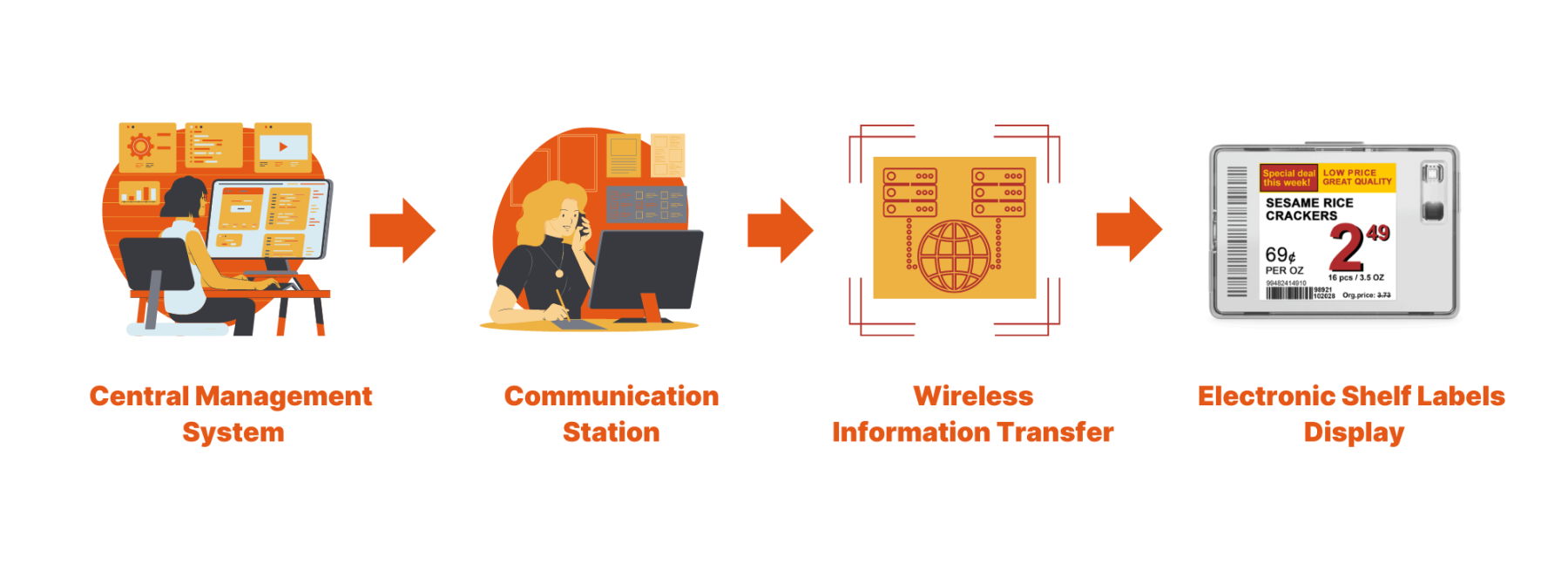Electronic Shelf Labels (ESLs), otherwise known as digital price tags, are a key component of effective retail operations. Whether they’re put to use in small convenience stores, large grocery stores, pharmacies or warehouses, this environmentally-friendly solution for price updates and inventory management is widely accepted as the new standard for on-shelf communication.
When it comes to efficient retail operations, digital price tags work for you. But how do they actually work? Let’s take a closer look at how this paperless, wireless technology functions.

Display technology
Electronic Shelf Labels (ESLs) work by using wireless technology to display and update product information digitally on retail shelves. Each individual digital display screen is linked to a central management system (more about that below). Some models only require power during updates.
Even though they are paper-free, digital shelf labels look almost like regular paper shelf labels. They can be made from electronic paper (E-paper) or liquid crystal display (LCD) screens, both of which display crisp, clean letters and numbers. Some models can also incorporate colours and other types of visual information.
For example, the SmartTAG™ line, a new generation of ESL available through JRTech, offers total freedom of design via a customizable screen. The e-ink used for displaying information on these tags can display bright colours and sharp and attractive graphics.
Many types of product information can be displayed using digital price tags, including stock levels, promotions, nutritional information and QR codes. They can even be integrated with a low-power, flash notification system to facilitate product identification by store employees who are fulfilling online orders or restocking shelves.
Central management system
A central server or label management software controls the entire ESL system. This software processes and packages product data and prices into information packets, which are sent to communication stations.
These stations relay the information to individual digital price tags throughout the store. The ESL tags receive the transmitted data and displays are updated accordingly, showing new prices or other product information.
Central management means fast, efficient and cost-effective label updates, leading to the complete optimization of your in-store operations management. After the initial investment, retailers can save costs on labour and materials by doing label updates digitally, instead of manually by store staff. This also reduces the risk of error, as labels are controlled at a single source and can be updated in batches of any size.
Wireless communication
Wireless communication is what makes electronic price tags so efficient. A central server sends information to communication stations using wireless networks.
While some ESL systems rely on radio-frequency to do updates, this type of system can potentially involve delays to batch updates. Infrared electronic shelf labels, such as those sold by JRTech, have the advantage in terms of both speed and reliability. Visible light communication is also used, though less often.
All types of wireless communication means labels can be updated as often as necessary, with no paper waste or time-consuming printing operations.
ESLs can also be implemented in combination with advanced IoT technologies and systems that make the most of AI tools. As part of a larger strategy, digital labels can be used to enhance shopping personalization and perform advanced data collection and analysis, leading to greater profits and higher levels of consumer trust.
How electronic shelf labels could work for you
Electronic Shelf Labels facilitate supply chain management by making it possible to update and adjust pricing and other information across thousands of displays rapidly and efficiently. The ability to implement dynamic pricing strategies quickly and efficiently will give retailers a competitive edge in a fast-evolving market.
They also serve as more than simple display tags, enabling coordination with inventory management software, mobile payments using NFC technology, and other internet-based functions and solutions. Geolocation and Put-to-light technologies can also be integrated for even more advanced functionality.
ESLs are designed to be energy-efficient, with some models offering battery life of up to 10 years. As such, they are more than just a paper replacement: they are a practical, environmentally-responsible long-term solution for retail labeling that can save millions of tons of waste per year.
By automating the price update process, ESLs help retailers reduce labor costs and improve pricing accuracy. They can provide valuable data on customer behavior when integrated with other retail technologies.
JRTech supplies Electronic Shelf Labels to leading retailers
The electronic shelf labels sold by JRTech represent the most reliable price automation system in the world.
You can trust these solutions to provide high-performing results in a variety of retail environments.
Contact us today to learn how our solutions can help your business embrace the future of shelf label technology.

